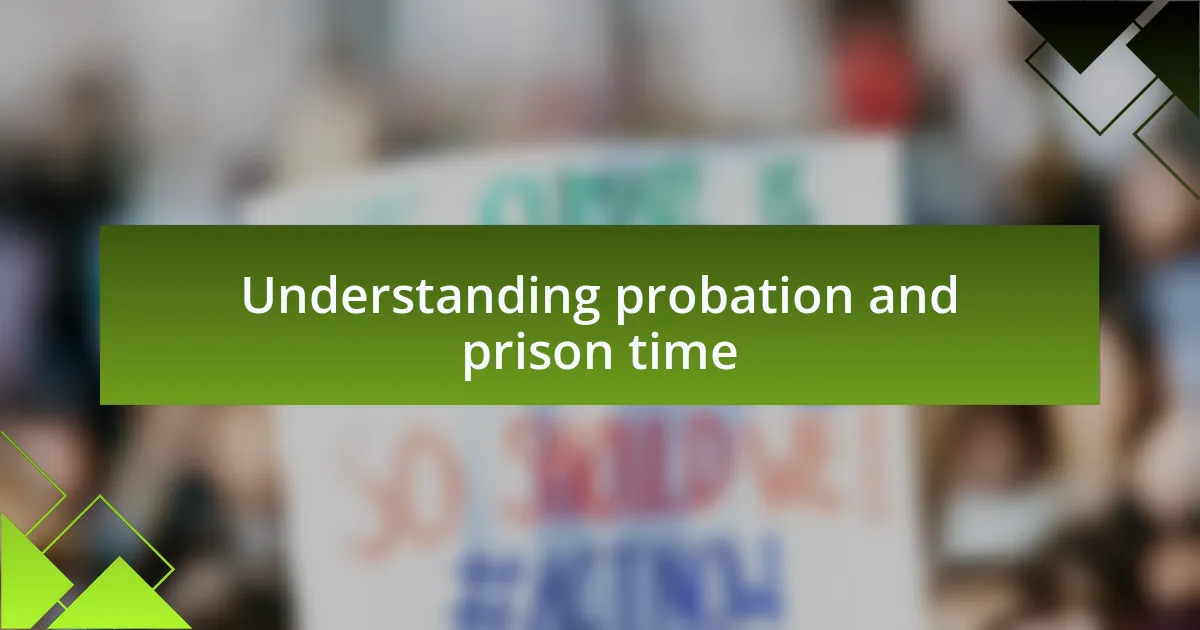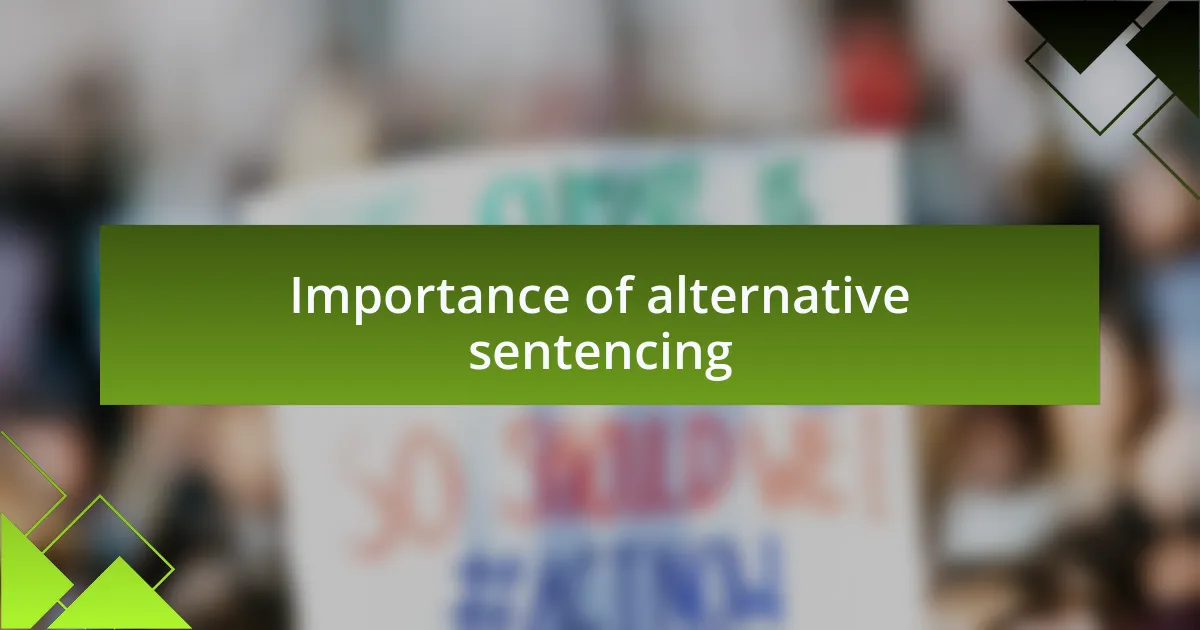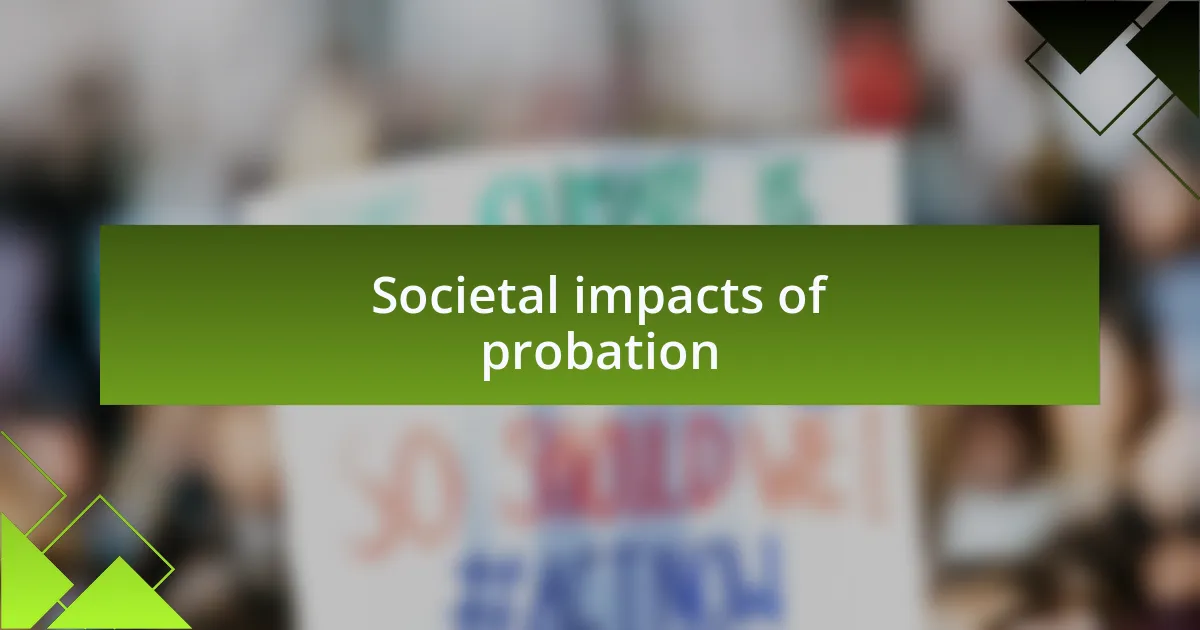Key takeaways:
- Probation allows for supervised reintegration into society, promoting personal growth and maintaining family bonds, while prison often leads to isolation and despair.
- Alternative sentencing, such as community service, benefits offenders by fostering accountability and reducing recidivism rates, ultimately strengthening communities.
- Probation is less costly for taxpayers compared to incarceration and enables individuals to contribute positively to local economies.
- Rehabilitation through probation can break intergenerational cycles of crime, positively impacting families and communities as individuals reclaim their identities.

Understanding probation and prison time
Probation and prison time serve fundamentally different purposes in the criminal justice system. While probation is a form of supervised release that allows individuals to reintegrate into society under specific conditions, prison time involves confinement and serves as a punitive measure. Have you ever considered how someone feels, knowing they are a step away from freedom yet still tethered to the legal system?
During my time volunteering with ex-offenders, I witnessed the emotional strain that both options impose. One person shared how probation felt like a second chance—a way to demonstrate that they could change. In contrast, another described prison as a dark period, stripping away autonomy and hope. It made me ponder: can we truly rehabilitate someone who’s simply left to languish in a cell?
The stark realities of probation versus prison can shape an individual’s future in profound ways. On probation, an offender may be challenged to uphold their responsibilities while reintegrating, which often fosters personal growth. Conversely, the prison experience can lead to deep feelings of isolation and defeat. Can we find a balance that encourages transformation rather than deepening despair?

Importance of alternative sentencing
Alternative sentencing is crucial because it provides opportunities for rehabilitation rather than purely punishment. I remember a case where a young man caught up in theft was placed on probation instead of serving time. This decision allowed him to attend job training programs and reconnect with his family, leading to a constructive life change that prison could never have facilitated.
Moreover, engaging in community service as a form of alternative sentencing can help offenders see the impact of their actions firsthand. During one of my community outreach events, I noticed how a program helped one offender understand the value of giving back, which in turn sparked a genuine desire to make amends. Isn’t it powerful to think that accountability can stem from active participation in society rather than isolation?
When we offer alternatives to prison, it directly benefits communities by reducing recidivism rates. I’ve often thought about how a supportive network can create lasting change. If we prioritize rehabilitation over punishment, aren’t we investing in a safer future for everyone involved?

Arguments for probation over incarceration
When considering probation as an alternative to incarceration, one significant argument is the chance for personal growth. I recall working with a woman who faced drug-related charges; instead of a lengthy prison sentence, she was granted probation, which allowed her to join a rehabilitation program. This experience was transformative, as she not only conquered her addiction but also rebuilt her life, illustrating how freedom can foster progress in ways confinement never could.
Another compelling aspect of probation is the emotional toll of incarceration on families. I once met a father whose absence due to prison affected not just him but also his children, who struggled emotionally and academically. The simple act of staying present through probation helped him maintain bonds with his kids, ultimately contributing to a more stable home environment. Isn’t it astonishing that a community can be strengthened by keeping families intact rather than disrupting them?
Additionally, probation often imposes fewer financial burdens on taxpayers compared to incarceration. I’ve seen firsthand how reintegrating individuals into society through probation can positively impact local economies. By allowing offenders to work and contribute rather than locking them away, aren’t we making a more sensible choice for everyone involved? This pragmatic approach not only aids the individual but also promotes community well-being and economic stability.

Personal experiences with probation
I believe that probation can serve as a vital lifeline for individuals who might otherwise spiral further into despair. I once supported a young man on probation who had committed a non-violent offense. Instead of isolating him in a prison cell, the judge allowed him to participate in community service and vocational training. Watching him grow from a scared, uncertain young adult into a more self-assured contributor to society was incredibly rewarding.
Another experience that stands out for me involved a woman on probation who was navigating reentry into the workforce. The social stigma surrounding her offense weighed heavily on her, making it difficult to find a job. Yet, by providing her with the opportunity to volunteer and gain skills while on probation, I witnessed how her confidence bloomed. I often wonder, how could we afford to waste such potential by confining individuals when they can thrive outside?
It’s striking how probation can facilitate reconciliation rather than just punishment. I encountered a young man who, rather than being removed from his family, had the chance to attend family therapy sessions mandated as part of his probation. Seeing him work through issues with his parents and siblings emphasized for me how vital connections are. How do we expect individuals to reform if we sever their ties to the very support systems that can help them heal?

Societal impacts of probation
Probation can profoundly impact societal dynamics. For example, I remember volunteering at a community center where many probationers gathered. The friendships formed in that supportive environment not only facilitated healing but also helped reduce recidivism rates. When people feel connected, it fosters a sense of belonging and accountability that can benefit everyone involved. How much could our communities improve if we prioritized such connections instead of isolating individuals?
Another striking facet of probation is its potential to break intergenerational cycles of crime. I once met a father who was on probation while trying to rebuild his life for the sake of his children. By attending parenting classes as part of his probation, he learned skills that helped him foster a nurturing environment at home. This transformation impacted not just him but also his kids, who witnessed a positive model of change. Isn’t it worth considering how breaking that cycle could uplift entire families and communities?
In many ways, probation serves as a reflection of a society committed to rehabilitation rather than just punishment. When I see probationers engaging in community service, it becomes clear they are not just giving back; they’re reclaiming their identity. One young woman I encountered volunteered at a local shelter, and I could see her sense of pride grow with each shift. Isn’t it fascinating how providing opportunities for redemption can redefine both individual lives and the broader community?